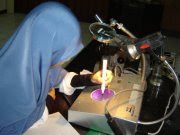Effect of Curdlan, a bacteria polysaccharide on rheological properties and microstructure of acid Milk curd
Ratmawati Malaka, Sudirman Baco, and Tomio Ohashi
(Faculty of Agriculture, Miyazaki University)
Objective
In dairy industry, the use of polysaccharide producing bacteria is of interest with respect to improvement of body and texture of milk product. Curdlan is extra-cellular slime polysaccharide of Alcaligenes faecalis var. myxogenes strain 10C3, which was isolated from soil as an organism capable of growing on a medium containing 10% ethylene glycol as the sole carbon source (Harada, 1987). Curdlan is added to foods to improve their properties and is also used to make new foods. Although curdlan have been widely investigated, we have not been found information about how effect of curdlan on acid milk curd. The objective of this study was to investigated the rheological properties and microstructure of acid milk curd with addition curdlan, fermented by lactic acid bacteria.
Materials and Methods
The acid milk curd as made from 10% reconstituted skim milk (RSM) added with 0 - 1% of curdlan, heated at 85oC for 30 second. This was inoculated with 1% of Lb. delbrueckii subsp. bulgaricus B-5b culture, and incubated at 37oC for 16 hours. The acid milk curd was studied toward viscosity by using a viscometer (Tokimec Inc.Visconic ED-model). Hardness, breaking energy and elastic modulus determined by using a Sanwa-Riken Jk.T. 264 Rheometer. The pH values were measured by using a TOAHM-30 pH-meter. Microstructure of acid milk curd viewed in a Hitachi S-4100 type scanning electron microscope.
Results
The used of curdlan in acid milk curd increased the apparent viscosity. Viscosity and pH of acid milk curd containing curdlan increased with increasing curdlan concentration. Viscosity and pH of acid milk curd with 0 - 1 % of curdlan increased from 64.7 to 342.24 mpa/sec and 4.53 to 4.96, respectively. Hardness and breaking energy of acid milk curd increased with increasing curdlan concentration. In a control acid milk curd containing no curdlan (0% of curdlan), only casein micelles and Lb. delbrueckii subsp. bulgaricus B-5b composed the gel microstructure. In general, there was somewhat higher degree of linking casein micelles into chains and clusters in the presence of curdlan than in control acid milk curd. Curdlan interact with casein micelles as string fluffy mass between one casein micelle and another casein micelle, and/or made fluffy mass film in the surface of clusters of casein micelle.
(Malaka, R., S. Baco., T. Ohashi. 1997. Japanene Society of Zootechnical Science, 9:36)






